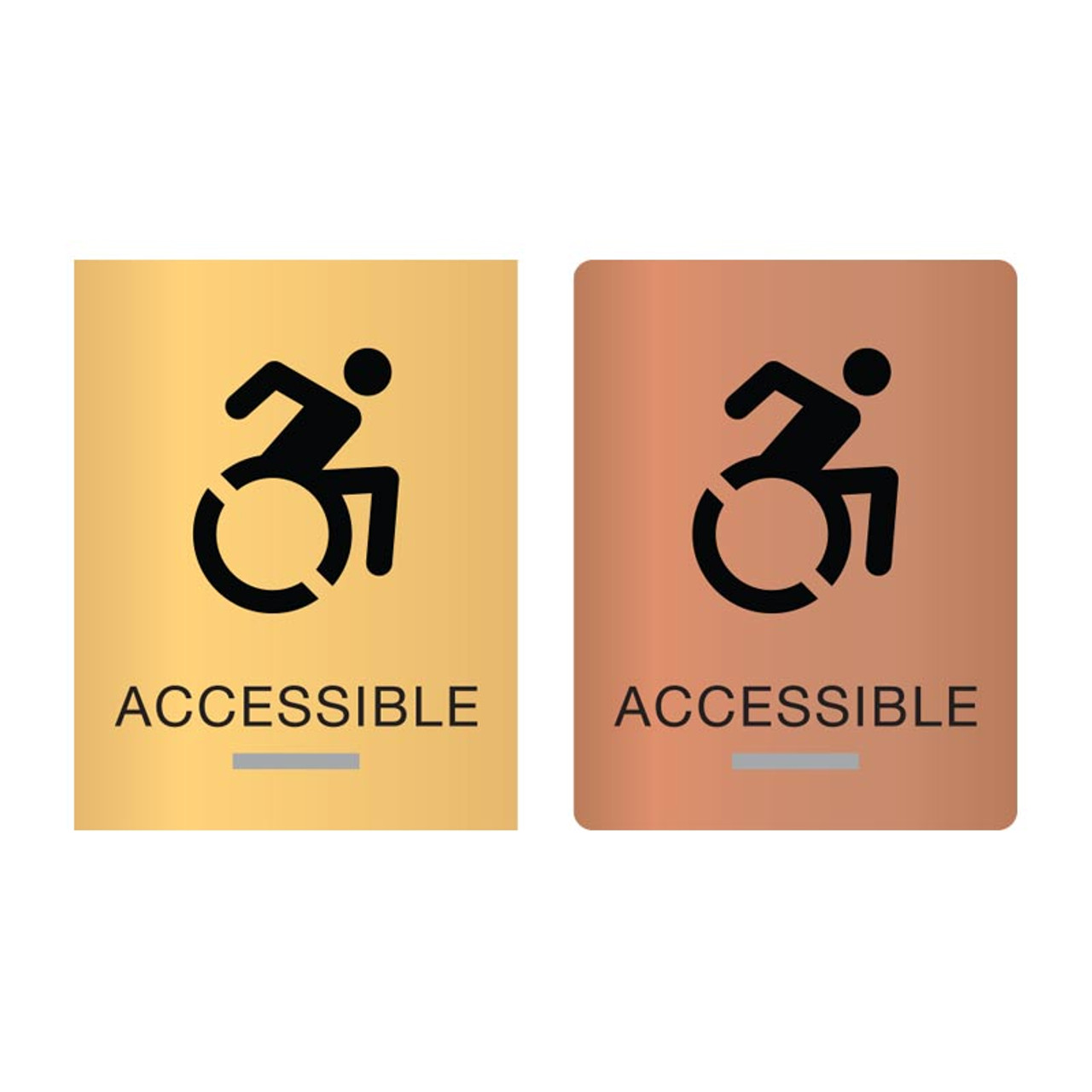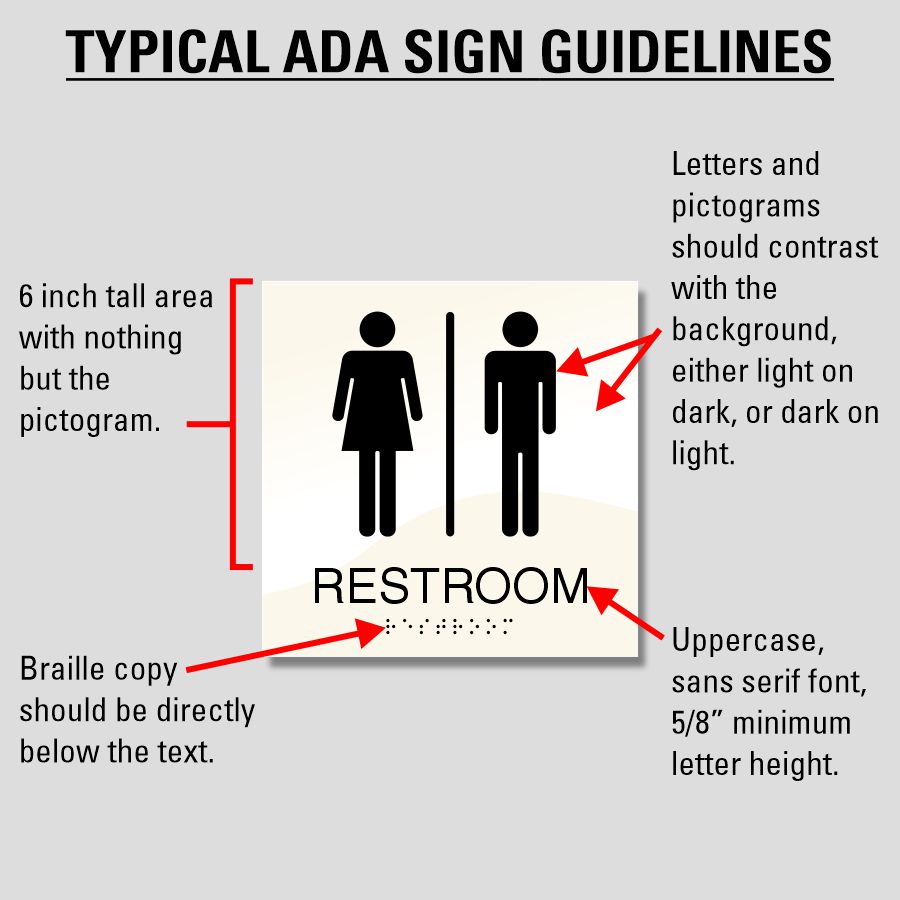The Advantages of Using Top Notch ADA Signs in Your Service
The Advantages of Using Top Notch ADA Signs in Your Service
Blog Article
Exploring the Trick Features of ADA Indicators for Enhanced Availability
In the realm of accessibility, ADA signs offer as quiet yet powerful allies, making sure that spaces are comprehensive and accessible for individuals with impairments. By integrating Braille and responsive elements, these indicators break obstacles for the visually impaired, while high-contrast color systems and clear font styles provide to varied visual requirements.
Importance of ADA Compliance
Making sure compliance with the Americans with Disabilities Act (ADA) is crucial for promoting inclusivity and equivalent accessibility in public spaces and work environments. The ADA, passed in 1990, mandates that all public centers, companies, and transportation services accommodate individuals with specials needs, guaranteeing they appreciate the same rights and opportunities as others. Compliance with ADA requirements not just satisfies lawful commitments yet additionally boosts a company's reputation by demonstrating its commitment to diversity and inclusivity.
One of the essential aspects of ADA compliance is the implementation of available signage. ADA indications are developed to guarantee that individuals with specials needs can conveniently browse via rooms and structures. These indicators must stick to specific guidelines concerning size, font, shade contrast, and placement to guarantee visibility and readability for all. Correctly carried out ADA signs assists eliminate obstacles that people with specials needs usually run into, therefore promoting their independence and confidence (ADA Signs).
Furthermore, sticking to ADA guidelines can reduce the threat of legal consequences and potential penalties. Organizations that stop working to comply with ADA standards may encounter penalties or legal actions, which can be both destructive and economically troublesome to their public image. Hence, ADA conformity is important to fostering an equitable setting for every person.
Braille and Tactile Aspects
The consolidation of Braille and responsive components right into ADA signs embodies the principles of availability and inclusivity. It is commonly placed beneath the corresponding text on signage to guarantee that individuals can access the info without visual help.
Responsive components expand past Braille and include raised icons and personalities. These elements are developed to be discernible by touch, allowing people to determine space numbers, washrooms, exits, and various other essential locations. The ADA sets particular guidelines regarding the dimension, spacing, and positioning of these responsive aspects to optimize readability and make certain uniformity across various atmospheres.

High-Contrast Color Design
High-contrast color plans play a critical duty in improving the visibility and readability of ADA signs for people with aesthetic disabilities. These schemes are important as they take full advantage of the difference in light reflectance between message and background, ensuring that indications are easily noticeable, also from a distance. The Americans with Disabilities Act (ADA) mandates using certain shade contrasts to fit those with minimal vision, making it an important aspect of compliance.
The efficiency of high-contrast colors exists in their ability to stick out in various illumination problems, including poorly lit environments and locations with glow. Normally, dark message on a light background or light message on a dark background is utilized to achieve optimum contrast. For example, black message on a white or yellow background provides a plain visual difference that assists in quick acknowledgment and comprehension.

Legible Fonts and Text Dimension
When thinking about the layout of ADA signs, the selection of legible fonts and suitable text size can not be overstated. These aspects are critical for ensuring that signs are available to individuals with visual disabilities. The Americans with Disabilities Act (ADA) mandates that check it out font styles should be not italic and sans-serif, oblique, manuscript, extremely attractive, or of uncommon type. These demands assist make sure that the text is quickly understandable from a distance and that the personalities are distinct Home Page to varied target markets.
According to ADA standards, the minimum text height ought to be 5/8 inch, and it must boost proportionally with watching distance. Uniformity in text dimension contributes to a natural visual experience, assisting individuals in navigating settings efficiently.
Additionally, spacing between letters and lines is essential to legibility. Sufficient spacing protects against characters from appearing crowded, improving readability. By adhering to these criteria, designers can significantly improve availability, making sure that signs serves its intended objective for all individuals, no matter their aesthetic capabilities.
Efficient Positioning Approaches
Strategic placement of ADA signs is essential for maximizing availability and making certain conformity with lawful standards. ADA guidelines stipulate that signs need to be mounted at an elevation between 48 to 60 inches from the ground to ensure they are within the line of view for both standing and seated individuals.
Furthermore, indicators must be put surrounding to the latch side of straight from the source doors to permit simple recognition before entry. Uniformity in indication positioning throughout a center enhances predictability, reducing complication and improving total customer experience.
Conclusion
ADA indicators play an important duty in promoting ease of access by integrating features that address the demands of individuals with handicaps. Incorporating Braille and responsive aspects ensures important information is obtainable to the visually damaged, while high-contrast shade systems and understandable sans-serif typefaces enhance presence across numerous illumination problems. Reliable placement methods, such as ideal installing heights and critical locations, additionally facilitate navigating. These aspects jointly cultivate a comprehensive atmosphere, highlighting the relevance of ADA conformity in ensuring equal access for all.
In the world of availability, ADA indications serve as quiet yet powerful allies, making certain that rooms are navigable and inclusive for individuals with handicaps. The ADA, passed in 1990, mandates that all public facilities, companies, and transport services accommodate people with impairments, guaranteeing they enjoy the same legal rights and chances as others. ADA Signs. ADA signs are developed to make certain that people with disabilities can easily navigate via structures and areas. ADA standards stipulate that indicators must be placed at a height in between 48 to 60 inches from the ground to ensure they are within the line of view for both standing and seated individuals.ADA indicators play an essential function in promoting availability by incorporating attributes that address the needs of individuals with specials needs
Report this page